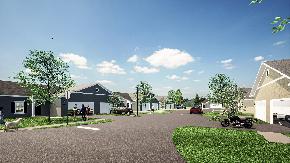
 BOSTON-Could the housing sector be feeling the first twinges of a recovery? If the data recently trickling in are any indication, it could be. Housing sales are actually rising in the country’s most depressed markets, including Nevada, Arizona, Florida and California, and average home prices are declining across the US at a lower pace as well. There’s less product being offered for sale and for shorter periods of time, and the vacancy rate among for-sale homes is also ticking down.
BOSTON-Could the housing sector be feeling the first twinges of a recovery? If the data recently trickling in are any indication, it could be. Housing sales are actually rising in the country’s most depressed markets, including Nevada, Arizona, Florida and California, and average home prices are declining across the US at a lower pace as well. There’s less product being offered for sale and for shorter periods of time, and the vacancy rate among for-sale homes is also ticking down.
Yet all of that good news is mainly on the single-family residence side of the market. The story is significantly different on the condominium side of the equation.
Over the first six months of the year, the median price for condominiums has leveled off and sales activity for condos on the market has picked up. Still, the available inventory remains high and, therefore, units put on the market are staying there for a longer period of time than before; approximately 15 months. According to Gleb Nechayev, a senior economist with locally based Torto Wheaton Research, it takes, on average, twice as long for a condominium unit to attract a buyer today than it did three years ago. As a result, the overall vacancy rate for owned multifamily product is on the rise.


Nechayev points out that sales durations for both single-family and condominium residences need to fall significantly before “meaningful growth” in prices can be seen. For this, you need “a combination of rising sales and falling for-sale inventory,” he notes. “While both housing segments are already on this path, condominiums are likely to lag unless sellers in the near term become willing to accept much lower prices.”
All in all, the condominium sector basically has more hurdles to overcome to recover, compared to single-family homes. For one, financing terms and requirements are stricter for anyone looking to buy a condo than they are for stand-alone homes. Since demand is feeling pressure, many homeowners looking to sell their suburban residences and funnel that capital into an urban condo are being forced to hold out until market conditions improve, or shelve their plans indefinitely.
Supply is also an issue. While builders of single-family homes were able to retrench and put a hold on adding supply to the market, condo developers continued to deliver new product. So since the beginning of the first quarter of 2006–the peak of residential construction–prices for both for-sale segments fell by 20% and single-family completions declined by 75%. Had the condo developers had a similar, immediate retraction, says Nechayev, the for-sale inventory would be 50,000 fewer units, just half of its increase over the same period, and the time units spent on the sales block would be falling as well.
Given its relatively small share of the market, particularly these days, it might seem that what’s going on the condo world would not matter too much. The sector accounts for just 10% of all for-sale housing deals and even less than the overall US housing inventory. But condo units tend to attract the same households that would rent multifamily product. As such, the segment has a huge impact on the multifamily market, and if it continues to underperform, condo prices would continue to fall as concessions rise. If not sold, condos could also revert back to the renter pool, particularly those condos owned by speculators. All of this will inevitably continue to lure would-be renters into the homeownership pool.
Take, for instance, Trump Parc Stamford, a 34-story condominium tower rising in Downtown Stamford, CT. Like with many condo projects today, the developers–in this case, a joint venture of Donald J. Trump and Louis R. Cappelli–have introduced a buyer incentive program. This one would make the cost of owning a new unit at the tower comparable to or less than what one may be paying in monthly rent for an apartment.
The developers have also reduced the required down payment to 10%; are providing buyer financing from select lenders at below-market rates; providing seller financing for up to 20% of the purchase price at an interest rate of just 2.5%; paying common charges and valet parking fees for up to 3.5 years; and providing job loss interest payment deferral on seller financing. Further, if the condo buyer sells its unit during the fourth or fifth year of ownership for less than what it paid, the developer will pay the difference up to 10% of the original purchase price.
The longer it takes for new multifamily supply, particularly for-sale product, to be absorbed, the longer it will take for the traditional apartment sector to improve. Given the current pace of condo development and sales, “any tangible improvement in multi-housing fundamentals is unlikely to begin for another year or so,” says Nechayev.
The good news, he adds, is “by the time the current condo overhang clears, the broader housing market and the economy are also expected to be on a more solid ground.” That will allow for a rebound in rental apartment absorption. “We don’t expect ‘heaven in eleven’ either, but the road to a real recovery in apartment rents and revenues should clear by then.”





 Copyright © 2024 ALM Global, LLC. All Rights Reserved.
Copyright © 2024 ALM Global, LLC. All Rights Reserved.





 BOSTON-Could the housing sector be feeling the first twinges of a recovery? If the data recently trickling in are any indication, it could be. Housing sales are actually rising in the country’s most depressed markets, including Nevada, Arizona, Florida and California, and average home prices are declining across the US at a lower pace as well. There’s less product being offered for sale and for shorter periods of time, and the vacancy rate among for-sale homes is also ticking down.
BOSTON-Could the housing sector be feeling the first twinges of a recovery? If the data recently trickling in are any indication, it could be. Housing sales are actually rising in the country’s most depressed markets, including Nevada, Arizona, Florida and California, and average home prices are declining across the US at a lower pace as well. There’s less product being offered for sale and for shorter periods of time, and the vacancy rate among for-sale homes is also ticking down. 








